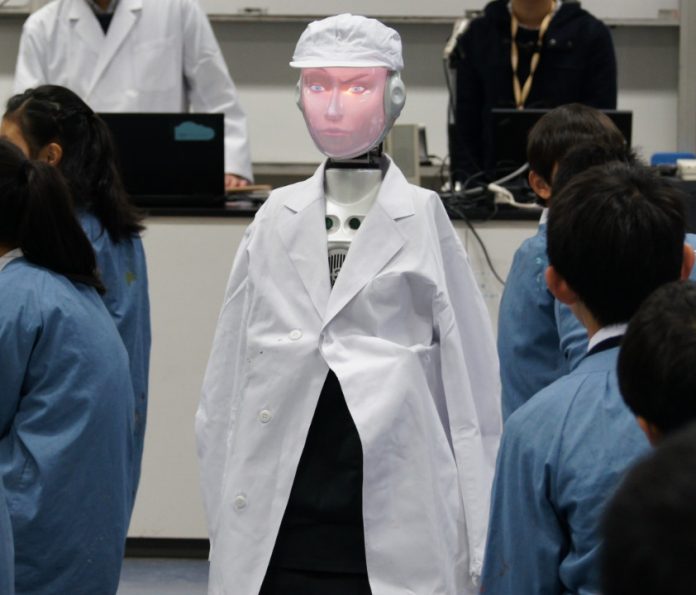Here, Professor Takahira Yamaguchi from Keio University, explores how AI&TA Robots are being used in primary school classrooms
-
Scenario Editor from Workflow Editor
When users represent a workflow of AI robots with PRINTEPS that has been described in last edition, they use the workflow editor. However, workflow is not fine in the domain of classroom with AI&TA (Teaching Assistant) robots at primary school. Lesson progress is represented not by a business process sequence, but the communication between teachers, pupils, robots, laptop computers and sensors.
To solve the gaps between workflow and lesson progress, we develop the scenario editor for teachers to represent their knowledge for lesson progress. They represent the five actors with the scenario editor. The scenario editor screen is divided into lanes, depending on the actors. Thus, they define the communication processes among the actors as shown in Figures 1.

-
Preparing robots, computers and sensors in classroom
We use Pepper and SociBot as AI&TA robots in lesson at primary school. Pepper is a humanoid robot from Japan and takes the role of talking with teachers. SociBot is a humanoid robot from the UK, that can change facial expression and take the role of giving pupils simple test questions, going around the classroom like Figures 2. We also set a Kinect v2 and a laptop computer on each table to detect a number plate. When Socibot gives the pupils a question, they put their number plate on the desk for their answer, and then Kinect detects the number and sends it to the main laptop. We also set up a display, a microphone, a Kinect v2, a laptop for AR and a Wi-Fi rooter.
-
Case study: Classroom with AI&TA Robots at primary school
We develop the classroom with AI&TA Robots for sixth-grade pupils at some primary school in December, 2016. The target lesson is “human anatomical structure and function” in science. After conducting anatomical experiments of frogs, the purpose of the lesson is to establish knowledge of the lesson for the pupils. There are four classes and each class has 36 pupils as shown in Figure 3. The lesson progress comes as follows: Pepper talks to the pupils and reviews the anatomical experiments of frogs last time, following the scenario developed by the teacher. Then SociBot gives the pupils simple test questions related with human anatomical structure and function. We prepare three kinds of quiz applications by PRINTEPS: the first review quiz about anatomical experiments of frogs, the second quiz about human organs using AR (Augmented Reality), and the third review quiz about the contents of the learning unit using tablets. Figure 4 shows the system configuration of the quiz system using AR.

-
Evaluation
To evaluate the classroom with AI&TA Robots at the primary school, we gave questionnaires to all the pupils who took the lesson. The questionnaire items were evaluated through five levels (1 is the best rating and 5 is the worst rating).
Q1 How did you feel about the teaching method of Pepper and SociBot?
Q2 How did you feel about the quizzes using AR?
Q3 How did you feel about the tablet quizzes?
Q4 How did you feel about the quizzes using the Robot, Kinect and Laptop? (Only 3 classes.)
Table 1 shows the questionnaire results with the average value from the numerical values of each cell of Q1–Q4 columns. The average of the evaluation is approximately 2. In particular, the evaluation of the quizzes using SociBot, Kinect v2 and laptop was the highest (1.76).

Thus, we conclude that most pupils are satisfied with the classroom use of AI&TA Robots.

-
Making classroom with AI&TA robots more popular
Although the scenario editor enables teachers to make lesson plans, it still takes a long time for them to do this. Therefore, teachers are still unable to understand the robot’s structure, and then how to operate the robots whilst relying on lesson progress.
Thus, we are developing a Reuse Tool for AI&TA Robots shown as Figure 5. Ten or more teachers at primary school joined our seminar for the reuse tool all over Japan, in August, 2019. We will continue with these seminars in the future, to further popularise the classroom use of AI&TA Robots.

Please note: This is a commercial profile











